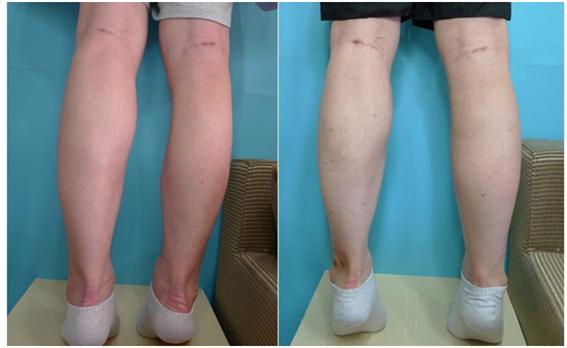
▶ Previous Artlcle: #4-3. A Case of Treatment for Side Effects of Calf Muscle Resection
Failure in cosmetic calf contouring surgeries may cause various calf deformities. In particular, failed muscle resection may lead to complications such as muscle contracture or shortening.
Fibrosis caused by muscle resection may induce skin dimpling and fibrous adhesions. Although there have been increasing cases of side effects caused by calf contouring surgeries, those side effects can be treated through a reconstructive surgery to correct calf deformities using stem cells. The hypertrophy that appears as a compensatory muscle development can be corrected through selective nerve blocking.
[Advertisement] MAGNUM(Q-switched Nd:YAG Laser) – Manufacturer: (www.i-dana.com)]
In addition, the intramuscular injection of fat-derived stem cells can improve muscle contracture, and the transplantation of fat mixed with stem cells is useful in treating side effects such as dimpling. Of course, if the patient received proper procedures from the beginning, he could have experienced more satisfactory outcomes.
However, being able to resolve difficulty in walking and skin irregularities on the calves seem to be tremendously rewarding for not only the patient suffering from side effects for long but also me with long experience in reconstructive surgeries.
No surgeons can perform a perfect surgery from the beginning. Even surgeons with long experience can perform a perfect surgery. However, I find it very important for any surgeon to carefully choose a surgical method well suited to their own skill and technique. All surgeons need to be aware that patients who suffer from post-operative complications would have a hard time, and such unfavorable outcomes would give a big ordeal to surgeons.
Also in the next issue, another case where side effects of a fat cosmetic surgery were treated will be described.

Figure 1. Photographs of a 35 years old male patient in tip-toe position. Preoperative view(left) and post operative view at 3months(right).
*Reference
In Suck Suh, MD., Ph. D. Classification and surgical Correction of Asymmetric Calves in Asians, Plastic and Reconstructive Surgery. 134(5):707e-716e, NOV 2014.
-To be continued




















